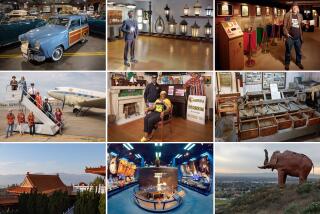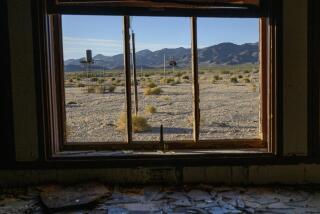Treasured Maps : California Map Society Meets at CSUN, Home of Cartographic Gems
- Share via
NORTHRIDGE — The 50 people who gathered at Cal State Northridge on Saturday had one thing in common: All are mad about maps.
The campus was the site of the 40th general meeting of the California Map Society, an organization of 165 members devoted to the preservation and celebration of maps. This year, there is much to celebrate. As members explained, cartography, or the making of maps, has undergone a revolution in the past decade. Thanks to computers and related technology, maps are easy and inexpensive to make for the first time in their history--one that predates the invention of written languages.
“It’s a revolution even greater than any of the previous revolutions in the history of cartography,” said Norman Thrower, a UCLA cartographer and historian who was the society’s first president.
Those earlier revolutions, he said, were the invention of printing, the use of statistical information and the invention of the airplane, which first allowed map makers to have the bird’s-eye view they had previously created out of surveyors’ data and their own imaginations.
The speed with which the new machines can generate maps is a marvel to anyone who went to graduate school 20 years ago and learned map making when a steady hand was almost as important a skill for a map maker as good information and a knack for design.
“I can turn out a finished map in less than 1/1,000th of the time I did when I came here 20 years ago,” former geography department chair William Bowen said during a talk on digital mapping of the socioeconomic landscape.
Thrower recalled how he had recruited a raft of graduate students to do the labor-intensive work of mapping the population of California, using the data from the 1960 U.S. census.
“It took five years before it could be published,” Thrower said of that pre-Macintosh map. “Now we could do that almost instantaneously.”
Many society members collect maps, in part, because they are often so beautiful.
Society President William Warren, a retired engineer who lives in Pasadena, is one such collector. He recalls with relish how he acquired a 1656 map by masterful Dutch map maker Henderick Doncker. Found on a wall in Amsterdam at the end of World War II, it shows California as an island, a vivid artifact from the period when the Spanish jealously guarded geographic information about California and the rest of New Spain from the outside world.
“Too expensive,” Warren told the dealer who asked $600 for the map, only to have his wife later give it to him as a gift.
However lovely a map may be, society members understand that maps are, above all, a means of communicating information. People’s lives have traditionally depended on the quality of their maps.
*
“In a sense,” Bowen said, “maps allow you intellectually to stand back from something and see the whole. With the new technology, we can literally see things that can’t be seen.”
For their makers, maps are often a tool of discovery. As a cartographer, Thrower said, “you never really know what you want to show. You make something and then you find out something.”
He gave as an example his 1960 map of California’s population. That revealed that 75% of the population lives on 2% of the land. “I also found that the center of the population is the San Fernando Valley.” Half the population of California lived north of the Valley--on 80% of the land that makes up the state.
Historically, maps have contained startling revelations. More reliable ways of measuring longitude expanded the boundaries of some European kingdoms and shrunk others. During the 1850s, physician John Snow mapped the cases of cholera in London and found that the greatest concentration clustered around the Broad Street water pump. The map pointed to the polluted water from the pump as the cause of the disease.
“Maps have a use besides decoration,” Bowen said.
During the meeting, members toured CSUN’s recently expanded map library, the largest in the California State University system. Housing some 300,000 maps, the map library occupied cramped quarters in Sierra Hall until Jan. 17, 1994. That was the date of the Northridge earthquake, when map curator Michael Swift joked, “God spoke, and he let us know that he wanted more room for the map library.”
Although map drawers tumbled, Swift said the library was fortunate that there was little or no damage to the jewel of the CSUN map collection, its extensive holdings of maps published by the Sanborn Map Co., beginning in the 1880s.
Originally designed for use by fire insurance underwriters in determining risk, those maps, still updated annually by the company that has since purchased Sanborn, provide detailed information about buildings in the commercial centers of most of the towns in the United States, including building materials and the presence of night watchmen.
“What makes this collection unique is that we have volumes for years that the Library of Congress doesn’t have,” Swift said.
Today, the collection is frequently used by companies preparing so-called Phase 1 reports, the legal documents required of owners to show that any environmental hazards have been addressed before the properties can be sold.
“I have 60 firms that are on our backs all the time to use the Sanborn maps,” said Swift, who has begun limiting use of the collection because he fears that constant handling will damage the increasingly fragile originals.
*
Although the maps were commercial in intent, they also reveal a great deal about the changing social geography of California and other states. Swift showed the group an 1888 Sanborn map of downtown Los Angeles, including Chinatown, that boasts both a sprawling vineyard and numerous houses of prostitution, euphemistically labeled “female boarding.” Some of the place names and descriptions on the maps include ethnic slurs that make a contemporary viewer wince.
One of the society members pointed out that the Sanborn maps are key documents for information about towns that no longer exist. Another noted that Sanborn maps are popular with bottle collectors, who pore over them for the locations of privies, into which a less ecologically savvy populace casually tossed its empties.
“We can map anything that someone is counting,” Bowen told the audience before showing dozens of what he called his “junk maps,” made quickly and inexpensively with the new technology, to explore themes--often controversial ones--that interest him. (The department has started a digital archive, available on the Internet, called the California Geographical Survey.)
One of Bowen’s maps was a spatial representation of Los Angeles’ “lifestyle index.” It uses data on per capita income, the extent of education among adults in a household, linguistic isolation and other factors to show where life is sweet (most of the Westside) and where it is hard (much of South-Central and the East Valley).
*
Maps of homicides and infant deaths showed similar patterns. Bowen contends that you can’t use income alone as a measure of how good life is because students are among the poorest people in the country and yet often live well by other measures.
The audience murmured over many of the maps that compared Los Angeles with other parts of the United States. With 9 million residents, Los Angeles is the most populous county in the country. “The population of the San Fernando Valley is larger than the population of the state of Nebraska,” Bowen noted.
Los Angeles also has the nation’s greatest number of adults without a high school education, “just short of 1 million,” Bowen said. In Appalachia, however, a higher percentage of the adult population is undereducated. Los Angeles also has the highest number of college graduates.
Bowen said that patterns tend to persist over time. He showed a student-made map from the 1970s that showed clusters of venereal disease in the central city, South Los Angeles and Hollywood. A more recent map showed similar clusters of AIDS cases.
“Inertia is the most powerful force on earth in human affairs,” Bowen opined. He also cautioned that venereal disease may be underreported among the privileged, who do not go to public clinics and whose physicians may be reluctant to lose patients by reporting them to health authorities.
“There’s no randomness,” said Bowen. “There’s always some kind of spatial story, although sometimes we don’t know what the story is.”
More to Read
Sign up for Essential California
The most important California stories and recommendations in your inbox every morning.
You may occasionally receive promotional content from the Los Angeles Times.










